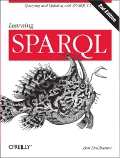Last Saturday morning, before getting on a plane from Frankfurt to Charlotte, North Carolina with a book that I knew wouldn't last that far, I went into a newsstand to find a big, glossy, British Formula One magazine to supplement my reading. I didn't find one, but I bought something else glossy and British: a special New Year edition of The Economist called "The World in 2007" with summaries of where various countries and industries are now and where they may go in the coming year.
![[Economist logo]](http://www.economist.com/images/economist_logo.png)
This special edition included lots of single-page essays from government and industry leaders such as Angela Merkel John McCain, Eric Schmidt, and Pedro Lamy. All of the essays that I started were predictable enough that I didn't finish them, until I got to the last page of the magazine, which had an essay with something I hadn't expected to see: a parenthesized list of of the three acronyms RDF, OWL, and SPARQL.
Huh? In a special edition of The Economist? The essay was called "Welcome to the Semantic Web," and of course the tech leadership figure that wrote it was Tim Berners-Lee. While some of us think that bnodes, reification, and traction for competing alternatives to RDF/XML are Big Issues to worry about, his essay made for a nice pep talk on the real big issues that form the grand vision of the Semantic Web.
You've probably read most of the essay's main points in other pieces he's written, but a newer one caught my eye:
Consider the financial services industry. Successful investment strategies are based on finding patterns and trends in an increasingly diverse set of information sources... Leading-edge providers of financial information are now developing services that allow users easily to integrate the data they have themselves—about their own portfolios or from their in-house market models—with the data delivered by the information service. The unique value creation lies in the integration service itself, not in the raw data on its own or even in the software tools, most of which will be built on open-source components.
The key to this integration is to use common data formats that link the information with identifiable vocabularies...
If you follow Planet RDF, I'm sure you can imagine where this discussion led, but the part quoted above reminded me of something that I've been thinking about. The financial community certainly has a lot of data. I've noticed that much of the effort in the use of the Extensible Business Reporting Language (XBRL) goes into careful development of machine-readable taxonomies, and I've wondered whether RDF/OWL technology can take advantage of these taxonomies to do something worthwhile. While it's a cliche that metadata is data about data, lots of RDF/OWL ontology metadata isn't about anything—"Ontologies for the sake of ontologies," as Dan Connolly put it—but financial metadata has plenty of data to go with it, so there should be lots of room for interesting new metadata applications.
Has anyone heard of any use of semantic web technology with financial data, with or without building on XBRL work?


I've played with the SEC's Edgar data source and turned some of it into N3 for fun to see what it would look like:
http://www.govtrack.us/data/rdf/sec.n3.gz
http://www.govtrack.us/rdfbrowse.xpd?uri=tag:govshare.info,2005:data/us/sec/cik0001308161
I'm not aware of financial data being encoded using RDF, OWL, etc. It is under consideration as a technology for modelling business contexts, and perhaps whole business models, for a future version of the ISO 20022 standard for generating banking/finance XML Schemas from models, although I should stress that it is only under evalution, it will be quite a while before any decision one way or another is made.
It doesn't make much sense to use RDF for data that fits neatly into a hierarchy, since XML does a perfectly good job of that. RDF might make sense for data where the structure needs to be flexible over time, e.g. perhaps for financial data distribution, since data vendors want to be able to add new information and new assocations between information in a timely manner, without waiting for standards or Schemas to catch up. This kind of RDF data might also aid "mash ups" that integrate financial data with other data, or which integrate financial data from multiple sources, which is an interesting use case.
Cheers, Tony.
Hi Tony,
I hadn't expected to find use of RDF in the financial community (you and I have discussed this before), but was more curious about people in the RDF/semweb community taking some financial data and building something around it. There is plenty of data and metadata out there in a nice machine-readable form, and I'm sure that it wouldn't take much XSLT to turn it into RDF for such a mashup.
Bob
Bob
The SEC's Edgar XBRL data feed is very low volume - months pass between new items
Hi Bob,
There is an European project called MUSING, which aims to provides innovative knowledge management solutions and services to support the execution of business intelligence activities, directly at the end-user premises. Part of the project includes representing XBRL data sources on Semantic Web ontologies. I have participated this work last summer in Innsbruck. For more detailed information, you may like to talk with Martin Hepp, who is the leader of ontology development in this MUSING project.
cheers,
Yihong